height VAUXHALL ADAM 2017.5 Owner's Manual
[x] Cancel search | Manufacturer: VAUXHALL, Model Year: 2017.5, Model line: ADAM, Model: VAUXHALL ADAM 2017.5Pages: 241, PDF Size: 7.33 MB
Page 9 of 241

In brief7Seat adjustmentLongitudinal adjustment
Pull handle, slide seat, release
handle. Try to move the seat back and forth to ensure that the seat is locked
in place.
Seat position 3 33, Seat adjustment
3 34.
Backrest inclination
Turn handwheel to adjust inclination.
Do not lean on backrest while
adjusting.
Seat position 3 33, Seat adjustment
3 34, Seat folding 3 35.
Seat height
Lever pumping motion
up:seat higherdown:seat lower
Seat position 3 33, Seat adjustment
3 34.
Page 10 of 241
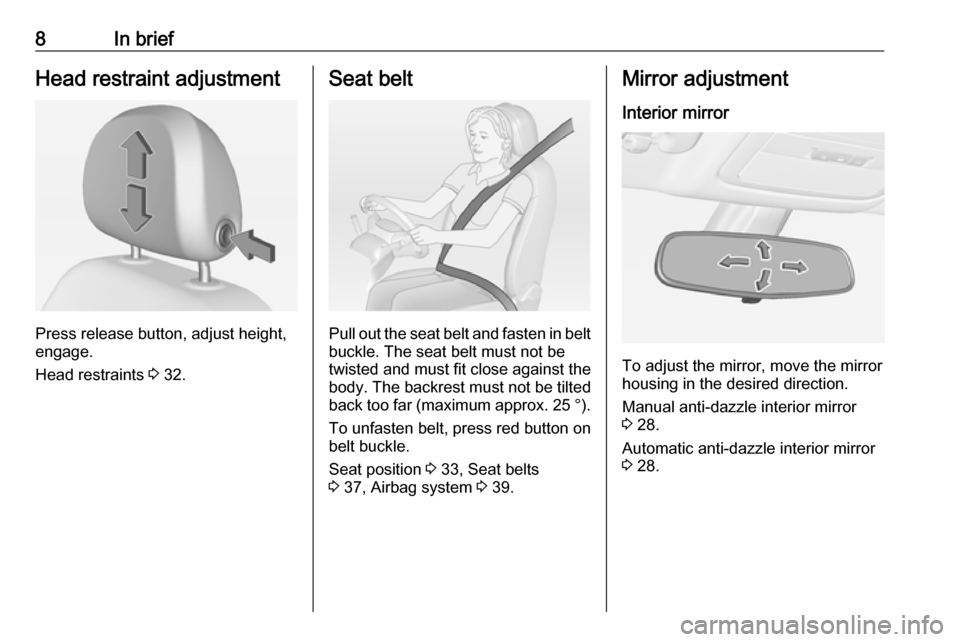
8In briefHead restraint adjustment
Press release button, adjust height,
engage.
Head restraints 3 32.
Seat belt
Pull out the seat belt and fasten in belt
buckle. The seat belt must not be
twisted and must fit close against the
body. The backrest must not be tilted back too far (maximum approx. 25 ° ).
To unfasten belt, press red button on belt buckle.
Seat position 3 33, Seat belts
3 37, Airbag system 3 39.
Mirror adjustment
Interior mirror
To adjust the mirror, move the mirror
housing in the desired direction.
Manual anti-dazzle interior mirror
3 28.
Automatic anti-dazzle interior mirror 3 28.
Page 34 of 241
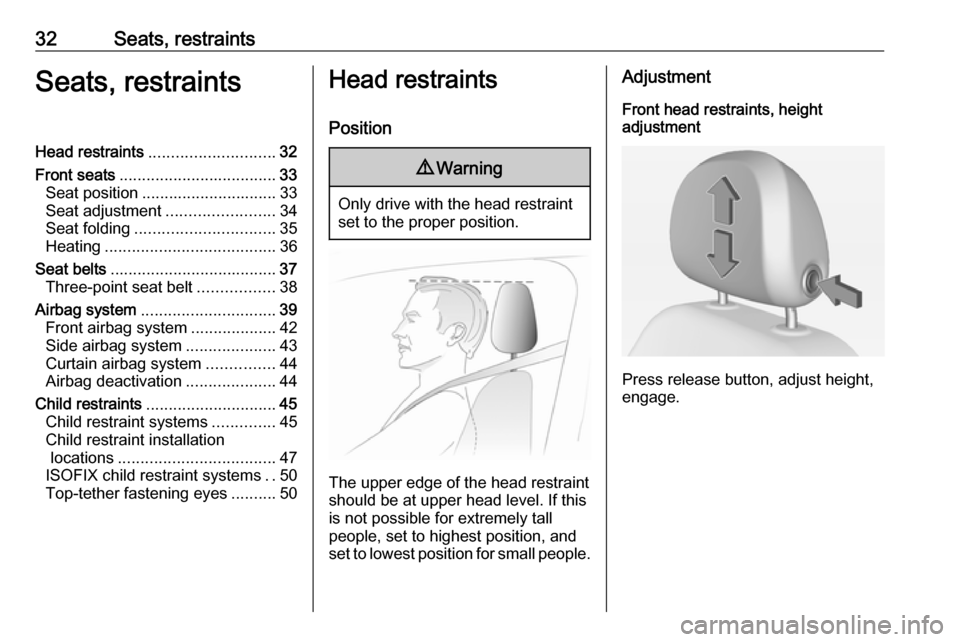
32Seats, restraintsSeats, restraintsHead restraints............................ 32
Front seats ................................... 33
Seat position .............................. 33
Seat adjustment ........................34
Seat folding ............................... 35
Heating ...................................... 36
Seat belts ..................................... 37
Three-point seat belt .................38
Airbag system .............................. 39
Front airbag system ...................42
Side airbag system ....................43
Curtain airbag system ...............44
Airbag deactivation ....................44
Child restraints ............................. 45
Child restraint systems ..............45
Child restraint installation locations ................................... 47
ISOFIX child restraint systems ..50
Top-tether fastening eyes ..........50Head restraints
Position9 Warning
Only drive with the head restraint
set to the proper position.
The upper edge of the head restraint
should be at upper head level. If this
is not possible for extremely tall
people, set to highest position, and
set to lowest position for small people.
Adjustment
Front head restraints, height
adjustment
Press release button, adjust height,
engage.
Page 35 of 241
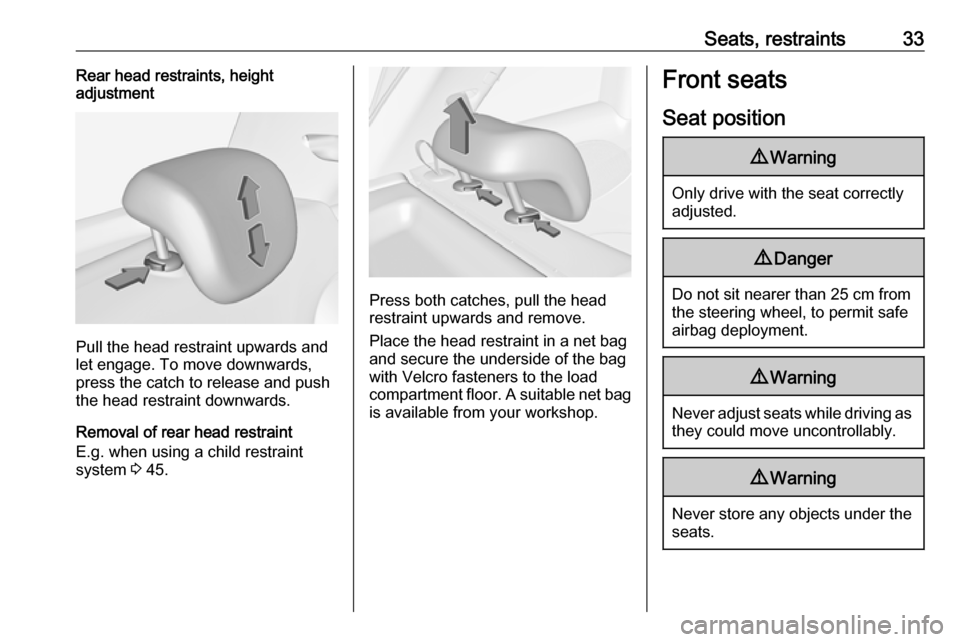
Seats, restraints33Rear head restraints, height
adjustment
Pull the head restraint upwards and
let engage. To move downwards, press the catch to release and push
the head restraint downwards.
Removal of rear head restraint
E.g. when using a child restraint
system 3 45.
Press both catches, pull the head
restraint upwards and remove.
Place the head restraint in a net bag
and secure the underside of the bag
with Velcro fasteners to the load
compartment floor. A suitable net bag
is available from your workshop.
Front seats
Seat position9 Warning
Only drive with the seat correctly
adjusted.
9 Danger
Do not sit nearer than 25 cm from
the steering wheel, to permit safe
airbag deployment.
9 Warning
Never adjust seats while driving as
they could move uncontrollably.
9 Warning
Never store any objects under the
seats.
Page 36 of 241
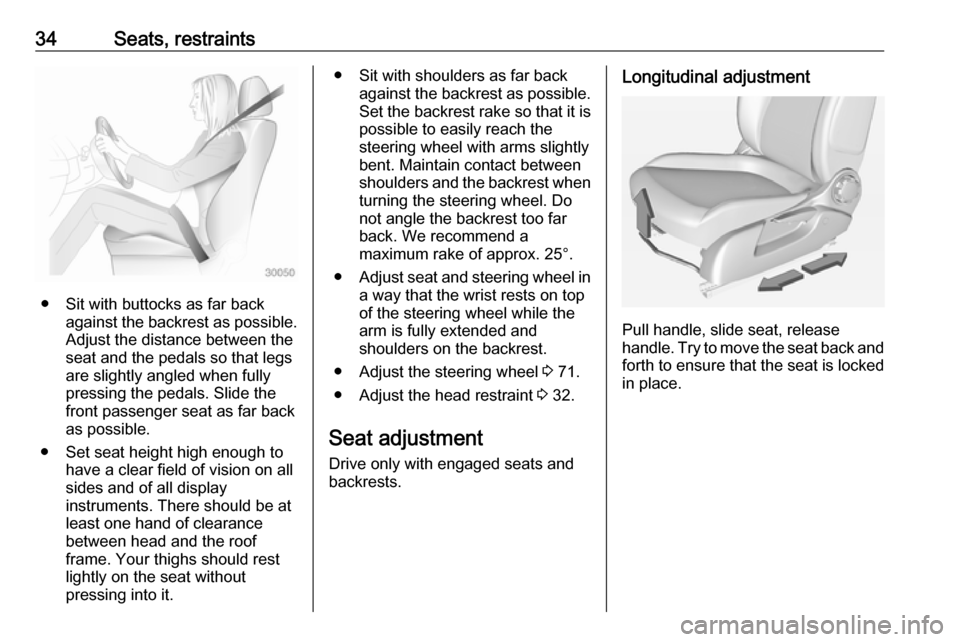
34Seats, restraints
● Sit with buttocks as far backagainst the backrest as possible.
Adjust the distance between the
seat and the pedals so that legs
are slightly angled when fully
pressing the pedals. Slide the
front passenger seat as far back
as possible.
● Set seat height high enough to have a clear field of vision on all
sides and of all display
instruments. There should be at
least one hand of clearance
between head and the roof
frame. Your thighs should rest
lightly on the seat without
pressing into it.
● Sit with shoulders as far back against the backrest as possible.
Set the backrest rake so that it is possible to easily reach the
steering wheel with arms slightly
bent. Maintain contact between
shoulders and the backrest when
turning the steering wheel. Do
not angle the backrest too far
back. We recommend a
maximum rake of approx. 25°.
● Adjust seat and steering wheel in
a way that the wrist rests on top
of the steering wheel while the
arm is fully extended and
shoulders on the backrest.
● Adjust the steering wheel 3 71.
● Adjust the head restraint 3 32.
Seat adjustment Drive only with engaged seats andbackrests.Longitudinal adjustment
Pull handle, slide seat, release
handle. Try to move the seat back and forth to ensure that the seat is locked
in place.
Page 37 of 241
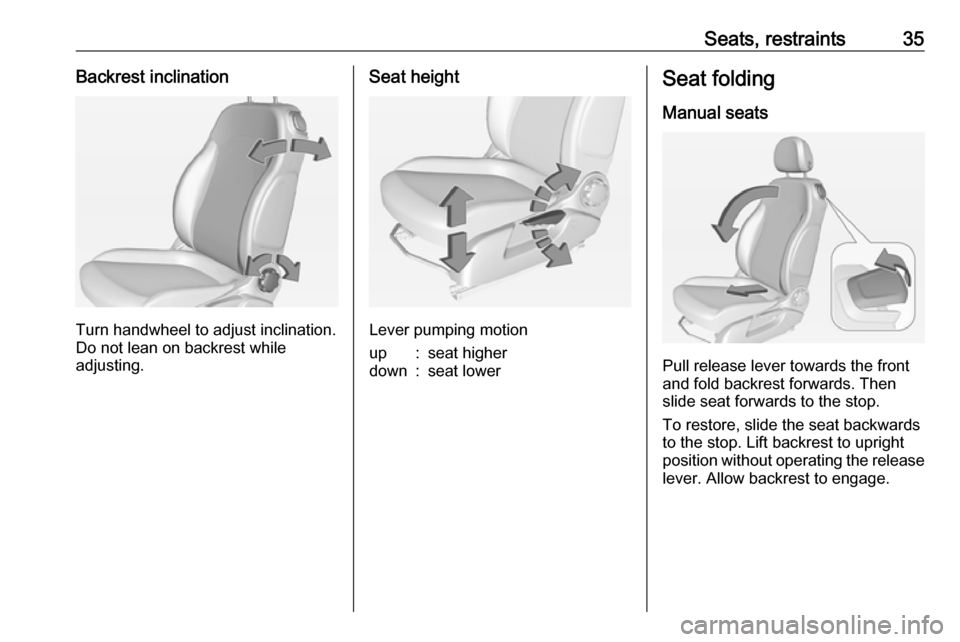
Seats, restraints35Backrest inclination
Turn handwheel to adjust inclination.
Do not lean on backrest while
adjusting.
Seat height
Lever pumping motion
up:seat higherdown:seat lowerSeat folding
Manual seats
Pull release lever towards the front
and fold backrest forwards. Then
slide seat forwards to the stop.
To restore, slide the seat backwards
to the stop. Lift backrest to upright
position without operating the release
lever. Allow backrest to engage.
Page 38 of 241
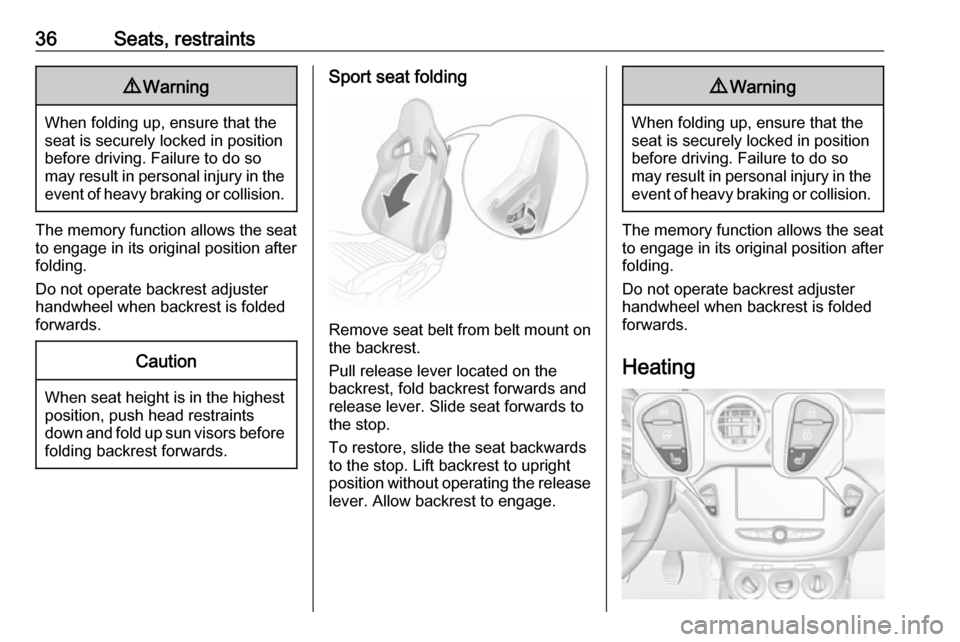
36Seats, restraints9Warning
When folding up, ensure that the
seat is securely locked in position
before driving. Failure to do so
may result in personal injury in the event of heavy braking or collision.
The memory function allows the seat
to engage in its original position after
folding.
Do not operate backrest adjuster
handwheel when backrest is folded
forwards.
Caution
When seat height is in the highest position, push head restraints
down and fold up sun visors before
folding backrest forwards.
Sport seat folding
Remove seat belt from belt mount on
the backrest.
Pull release lever located on the
backrest, fold backrest forwards and
release lever. Slide seat forwards to
the stop.
To restore, slide the seat backwards
to the stop. Lift backrest to upright
position without operating the release lever. Allow backrest to engage.
9 Warning
When folding up, ensure that the
seat is securely locked in position
before driving. Failure to do so
may result in personal injury in the event of heavy braking or collision.
The memory function allows the seat
to engage in its original position after
folding.
Do not operate backrest adjuster
handwheel when backrest is folded
forwards.
Heating
Page 49 of 241

Seats, restraints47Child restraint installation locations
Permissible options for fitting a child restraint system
Weight class
On front passenger seat
On rear seats
activated airbagdeactivated airbagGroup 0: up to 10 kgXU 1U*Group 0+: up to 13 kgXU 1U*Group I: 9 to 18 kgXU1U2
*Group II: 15 to 25 kgU **XU *Group III: 22 to 36 kgU **XU *1:if the child restraint system is being secured using a three-point seat belt, adjust seat backrest to a vertical position
to ensure that the belt is tight on the buckle side. Move seat height to the uppermost position.2:remove rear head restraint when using child restraint systems in this group 3 32*:move the respective front seat ahead of the child restraint system to one of the foremost adjustment positions**:move the front passenger seat to the rearmost adjustment position. Move seat height to the uppermost position and
the headrest to the lowest position. Adjust seat backrest as far as necessary to a vertical position to ensure that vehicle seat belt runs forwards from the upper anchorage pointU:universal suitability in conjunction with three-point seat beltX:no child restraint system permitted in this weight class
Page 157 of 241

Driving and operating155Side blind spot alert is active from
speeds of 6 mph up to 87 mph.
Driving faster than 87 mph
deactivates the system, indicated by
low lighting warning symbols B in
both exterior mirrors. Reducing the
speed again will extinguish the
warning symbols. If a vehicle is then
detected in the blind zone, the
warning symbols B will illuminate as
normal on the relevant side.
When the vehicle is started, both
exterior mirror displays will briefly
illuminate to indicate that the system
is operating.
The system can be activated or
deactivated in the Info-Display.
Vehicle personalisation 3 99.
Deactivation is indicated by a
message in the Driver Information
Centre.
Detection zones The detection zones start at the rear
bumper and extend approx. three metres rearwards and to the sides.
The height of the zone is between
approx. 0.5 metres and two metres off
the ground.The system is deactivated if the
vehicle is towing a trailer.
Side blind spot alert is designed to
ignore stationary objects, e.g.
guardrails, posts, curbs, walls and
beams. Parked vehicles or oncoming
vehicles are not detected.
Fault
Occasional missed alerts can occur
under normal circumstances and will
increase in wet conditions.
Side blind spot alert does not operate when the left or right corners of the
rear bumper are covered with mud,
dirt, snow, ice, slush, or in heavy
rainstorms. Cleaning instructions
3 208.
In the event of a fault in the system or if the system does not work due to
temporary conditions, a message is
displayed in the Driver Information
Centre. Seek the assistance of a
workshop.Fuel
Fuel for petrol engines Only use unleaded fuel that complies
with European standard EN 228 or
equivalent.
The engine is capable of running with
fuel that contains up to 10% ethanol
(e.g. named E10).
Use fuel with the recommended octane rating. A lower octane rating can reduce engine power and torque
and slightly increases fuel
consumption.Caution
Do not use fuel or fuel additives
that contain metallic compounds
such as manganese-based
additives. This may cause engine
damage.
Page 168 of 241
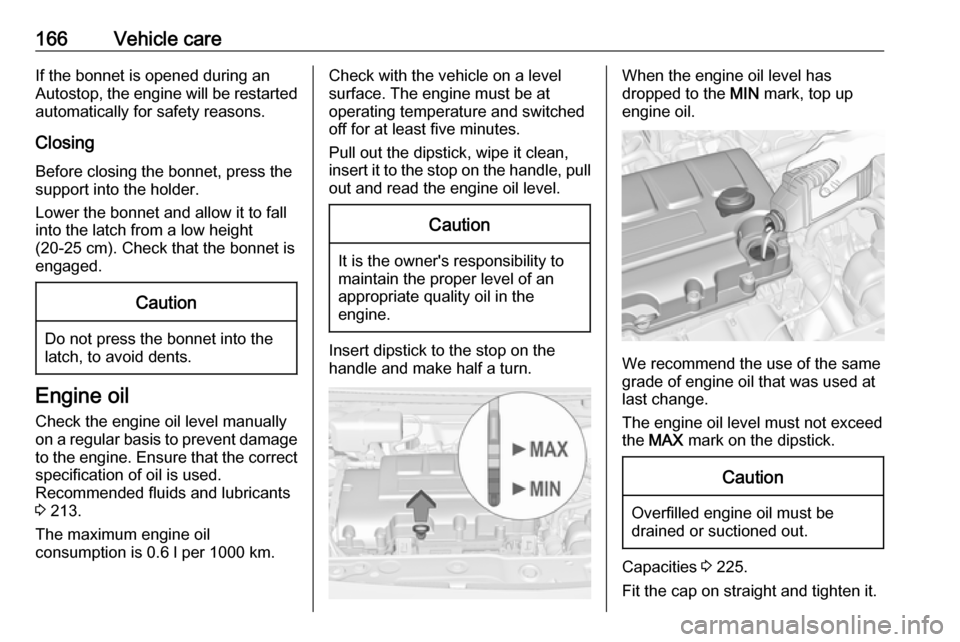
166Vehicle careIf the bonnet is opened during anAutostop, the engine will be restarted automatically for safety reasons.
Closing
Before closing the bonnet, press the
support into the holder.
Lower the bonnet and allow it to fall
into the latch from a low height
(20-25 cm). Check that the bonnet is engaged.Caution
Do not press the bonnet into the
latch, to avoid dents.
Engine oil
Check the engine oil level manually
on a regular basis to prevent damage
to the engine. Ensure that the correct specification of oil is used.
Recommended fluids and lubricants
3 213.
The maximum engine oil
consumption is 0.6 l per 1000 km.
Check with the vehicle on a level
surface. The engine must be at
operating temperature and switched
off for at least five minutes.
Pull out the dipstick, wipe it clean, insert it to the stop on the handle, pull
out and read the engine oil level.Caution
It is the owner's responsibility to
maintain the proper level of an
appropriate quality oil in the
engine.
Insert dipstick to the stop on the
handle and make half a turn.
When the engine oil level has
dropped to the MIN mark, top up
engine oil.
We recommend the use of the same
grade of engine oil that was used at
last change.
The engine oil level must not exceed
the MAX mark on the dipstick.
Caution
Overfilled engine oil must be
drained or suctioned out.
Capacities 3 225.
Fit the cap on straight and tighten it.